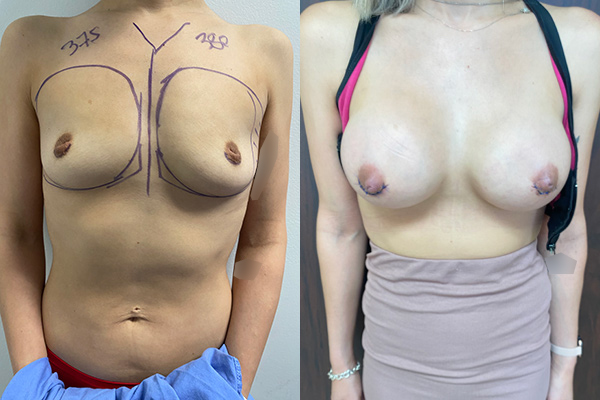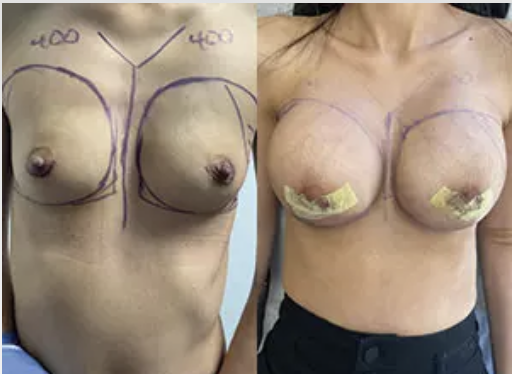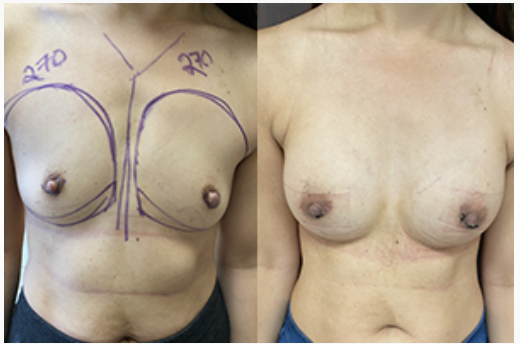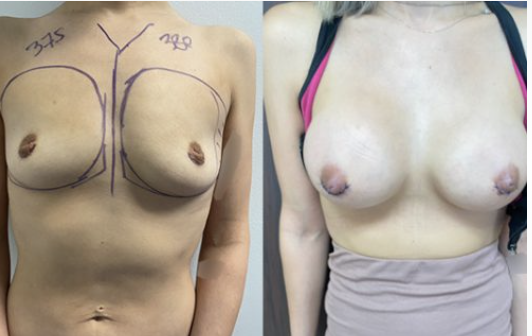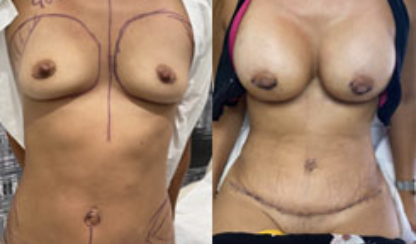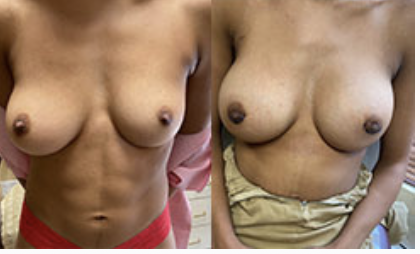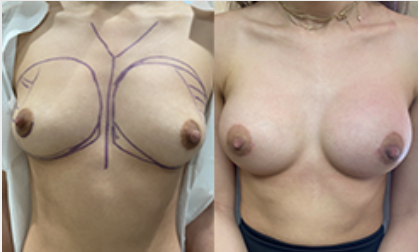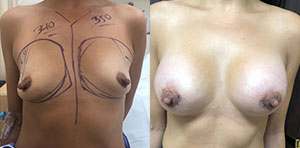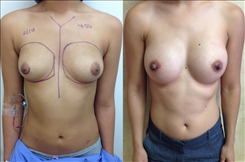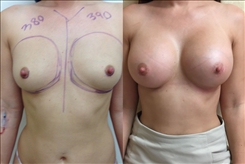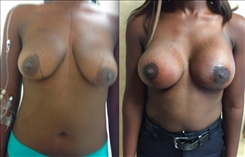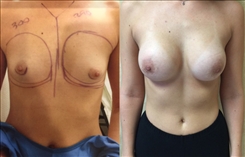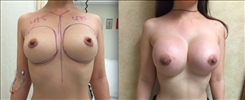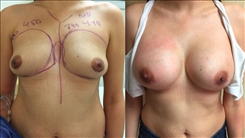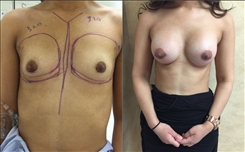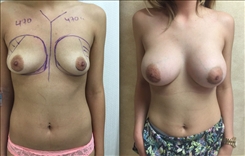
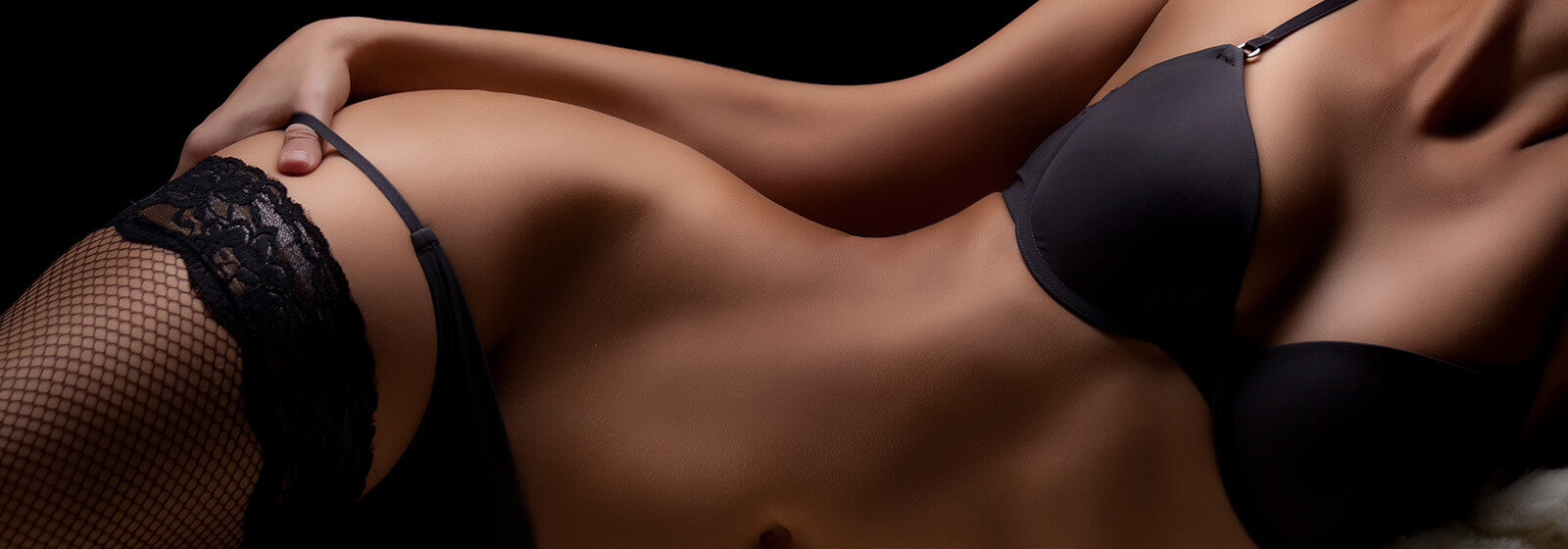
Breast Augmentation
Breast augmentation surgery enhances a woman’s appearance by increasing volume and improving her shape. Dr. Linder has been performing breast enhancement procedures in Beverly Hills since 1997 and has placed over 14,000 breast implants.
If you want to counteract the damage from the rigors of pregnancy or breastfeeding or have always been displeased with the lackluster size and shape of your breasts, breast augmentation may be appropriate for you. This customizable surgery allows you to achieve the full, shapely breast contours that you have always wanted, whether it is a subtle increase or a noticeable enlargement.
Women choose breast enlargement surgery for various reasons at different stages of their lives. While no two procedures are identical, many women turn to this cosmetic enhancement to address at least one of the following:
- Achieve a more balanced and proportionate body contour
- Improve your breast shape
- Enhance your cleavage
- Improve your breast projection
- Restore lost volume due to aging, pregnancy, or weight loss
- Improve your appearance in bathing suits or clothing

Ideal Candidates
Ideal candidates do not smoke, are in good overall health, and have realistic expectations of their results. The decision to undergo breast enhancement is a deeply personal choice that you need to make for yourself.
Women who consider surgery often complain that their breasts:
- Are sagging, flattened, elongated, or asymmetrical
- Lack adequate cleavage or volume
To better determine your goals and explain your expectations, ask yourself what is essential to achieve with this plastic surgery.
How Old Do You Have to Be for Breast Augmentation?
Dr. Linder will not perform breast augmentation on teenagers under the age of 18. The only exception are teenagers with severe congenital deformities (such as significant asymmetry or Poland’s Syndrome). Younger patients will need to provide sign-offs from their pediatrician and their parent or guardian.
Saline implants are FDA approved for women over 18; silicone implants are FDA approved for women over 22.
Are you Ready for Your Breast Augmentation?
Dr. Linder prides himself on educating his patients throughout the process, beginning with the consultation and extending all the way to the last follow-up appointment.
Benefits of Breast Augmentation
Restores a Youthful Look
After pregnancy, breastfeeding, or weight loss, the breasts can appear deflated and aged. Implants restore the breast volume women may have had in their youth or during pregnancy, achieving a firmer, more youthful breast contour. This procedure can be combined with breast lift to rejuvenate sagging breasts
Improves Balance and Shape
Augmentation surgery can improve a variety of issues, including tubular (constricted) breasts and breasts that are noticeably different sizes (asymmetrical). Implants create a rounder and more attractive bust, and implants of varying sizes can be used to correct asymmetry.
Improves Fullness (Size)
With breast augmentation, women with a naturally small chest can enhance their cleavage and fullness. Women whose breasts have deflated can also benefit from implants to fill the space beneath the skin. The ideal implant size and shape will be determined based on your physical attributes and personal goals.
The specific breast implants used depends on the amount of existing tissue and aesthetic goals a patient has for her enhanced breasts. While many women assume that size is the only differentiation between implants, it is only one factor.
The brand, shape, material, and profile determine how an implant will sit in the chest and enhance contours.
Dr. Linder prefers smooth, high-profile saline and silicone implants by Mentor® Corporation, Allergan Pharmaceuticals, or Sientra®. All three are FDA approved.
Implant Material
Advancements to breast implants have improved their safety, reliability, and ability to provide stunning results.
Breast implants (of any material) are available in a wide variety of size and shape options, depending on your natural tissue, physical build, and aesthetic desires.
Silicone Implants
These implants are ideal for thin-chested women and produce a more natural appearance. There is a higher risk of capsular contracture and scar tissue formation, and due to the cohesive nature of the silicone filler, rupture can only be detected with an MRI.
- Cohesive silicone implants: These implants consist of a thicker silicone gel that better maintains its shape (even if the case of an implant rupture). Cohesive silicone implants promote a smooth, natural silhouette with a soft and natural feel.
- Gummy bear implants: These teardrop-shaped implants mimic the shape and slope of a natural breast. Because these are sloped, they do not always provide as much upper-pole fullness. Gummy bear implants consist of cohesive silicone gel (to maintain shape).
- Extra-full implants: The Natrelle INSPIRA™ is an extra-full profile highly cohesive silicone implant that provides the benefits of gummy bear implants while maintaining upper pole fullness.
- MENTOR® MemoryGel® XTRA: These implants are filled with a proprietary silicone gel that is less prone to rippling, softer, and more natural-feeling.
Saline Implants
Saline implants are filled with a sterile saline solution. Rupture is immediately noticeable without diagnostic testing, and any saline filler leakage can be safely absorbed by the body. They tend to produce a more visible and less natural look, particularly with subglandular placement. These implants are available in round or contoured shapes with various profiles.
- MENTOR® Moderate Plus Profile Style 2000: This smooth implant adds dimension to the breast with more projection than previous styles.
- MENTOR® Round High Profile Style 3000: This high-profile implant provides the highest projection for petite women and those with narrow chest walls.
Traditionally, Dr. Linder will suggest saline implants for younger women who are still looking to get pregnant and breastfeed. He believes that saline implants are safer and more convenient (since silicone implants require MRIs every three years). Women in their 30s and 40s who have already had children often choose silicone implants for their natural feel.
Implant Profile
The profile determines the correlation between the implant’s base width and height. Traditional breast implant profiles are as follows:
- Low: useful for women desiring minimal projection (these are the least common option).
- Moderate: useful for women with broad chest walls. An example of a moderate profile implant includes MENTOR® MemoryShape® (available in all profiles).
- High: useful for patients with thin chest walls (these are the most commonly used implants). These provide upper pole fullness throughout the life of the implant. An example of a full profile implant includes the Natrelle INSPIRA™ SCF.
- Extra High: useful for patients who desire larger implants and increased upper pole fullness. An example of an extra full profile includes the Natrelle INSPIRA™ SCX implant or the MENTOR® MemoryGEl® XTRA High Profile.
- Mentor® MemoryGel® BOOST: offers a BOOST effect that’s designed to last without losing their natural feel.
The implant profile chosen should take into account the size and shape of a woman’s natural breast as well as her physical build, such as shoulder and chest width.
Implant Size
There are multiple factors that go into determining implant size. Some of these factors include your current measurements, characteristics, and the size of your chest wall. While we often recommend implants that will be in proportion with your body frame, your personal desires and goals will be taken into account.
Breast Augmentation Incision
- Inframammary incisions are created along the breast crease and allow for optimal pocket creation. This technique does produce visible scarring, but scars are likely to fade over time and can be concealed with clothing.
- Periareolar incisions are created along the lower portion of the areolas and allow for optimal pocket creation. This technique produces scars that are easy to conceal.
- Transaxillary incisions are placed within the armpit, which leaves no visible scarring on the breasts.
- Transumbilical incisions are placed in the belly button, which leaves no visible scarring on the breasts.This technique is not commonly recommended.
Will I Be Able to Breastfeed After Breast Augmentation?
The loss of breastfeeding is approximately five to eight percent of elective cosmetic breast augmentations by board-certified plastic surgeons throughout the United States. However, the numbers increase to 12 percent to 15 percent if a breast reduction or breast lift (mastopexies) are involved.
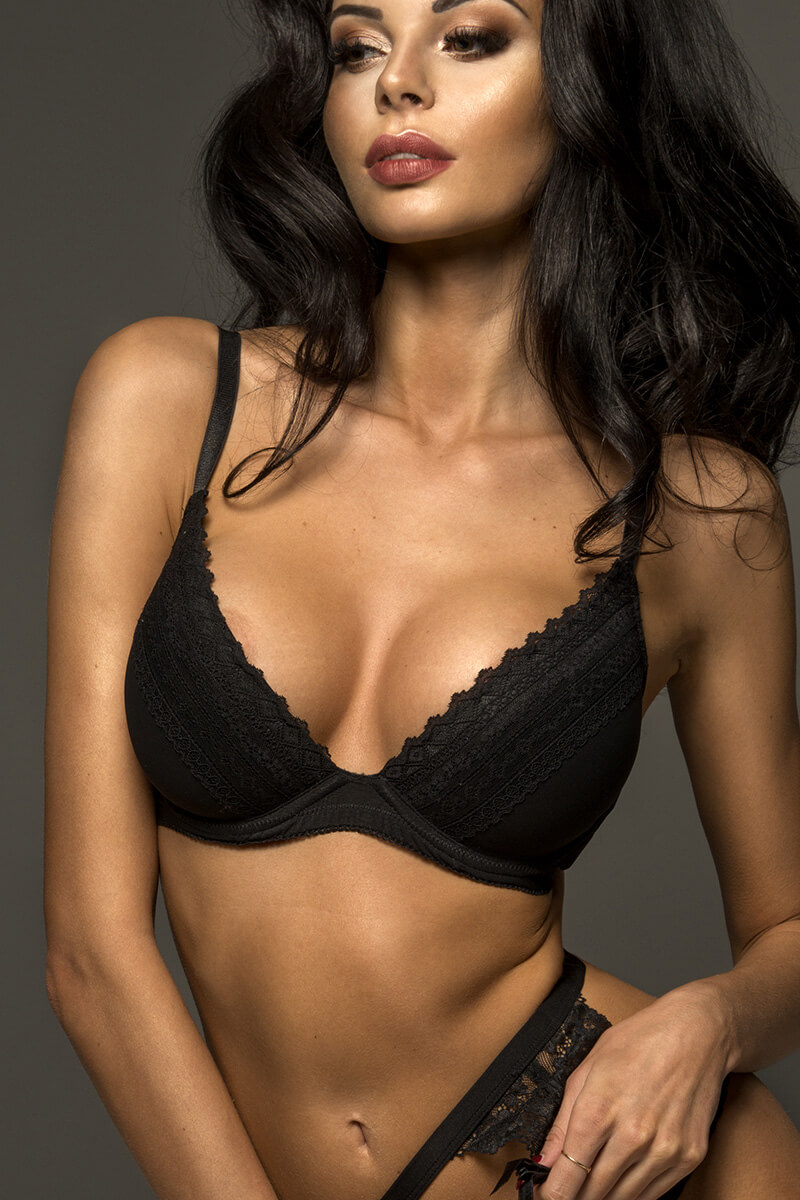
Implant Placement
Women undergoing breast augmentation have two options regarding how the implant is placed in their chest. This decision will impact how the implants look and how they respond to different movements (such as contractions during exercise).
The appropriate choice will depend on the woman’s specific anatomy, and will be determined by Dr. Linder during the consultation.
Subpectoral placement involves using the dual plane technique: two-thirds under the muscle medially and one-third over laterally. This allows coverage of the implant and reduction of visibility along the sternal area and cleavage region. There is a reduced risk of capsular contracture and scar tissue formation, and it has also been shown to be helpful for mammograms and MRIs in detecting cancers. The majority of our patients receive subpectoral implant placement.
This placement is ideal for women with minimal natural tissue, as placement under the muscle helps to conceal the outer ridges of the implant (therefore minimizing rippling).
Subglandular placement may be useful for patients with severe tubular breast deformity; however, in the majority of these cases, Dr. Linder still performs the dual plane technique with the last sum medial muscle coverage just in case the patient experiences weight loss in the future.
The subglandular placement is often recommended for women with thick chest walls and pectoral muscles.
How Much Does Breast Augmentation Cost in Beverly Hills?
The cost will vary per patient. The price includes surgeon’s fee, operating room fees, implant cost, and anesthesia fees. In general, silicone implants are more expensive than saline implants.
To get a more accurate cost estimate, please contact our office for a consultation.
Contact UsBreast Augmentation Surgery Information:
Where Are the Surgeries Performed?
Dr. Linder performs most of his breast augmentation surgeries at the Summit Surgical Center in Beverly Hills, California. The surgery center is fully accredited and certified by the American Association for Accreditation of Ambulatory Surgery Facilities, Inc., and Medicare.
He also has privileges at the premier medical center Cedars-Sinai in Los Angeles and has been an Attending Surgeon in the Division of Plastic and Reconstructive Surgery since 1997.
What Type of Anesthesia Is Used?
Breast enlargement surgery is performed under general anesthesia with a board-certified anesthesiologist. Laryngeal mask airways are used with the majority of patients. However, those who have a history of reflux or gastroesophageal disease are usually better candidates for endotracheal tube intubation.
What Surgeries Are Performed in Combination?
Breast augmentation can be performed alone or in addition to other plastic surgeries, such as:

Your Consultation
Your consultation is essential before your plastic surgery. This consultation will give you a chance to meet with Dr. Linder (our board-certified plastic surgeon). However, before scheduling a consultation, you should prepare so you can make the most of your appointment.
Determine if you are a good candidate for breast augmentation by asking yourself these questions.
- Are you in good overall health?
- Do you have a realistic expectation for the outcome of your procedure?
- Are you emotionally mature enough to make an essential decision regarding altering your appearance?
- Are you over 18 (for saline implants) or over 22 (for silicone implants)?
- Can you fit the cost of a breast augmentation procedure into your budget?
Breast Augmentation Surgery Timeline
Preoperative
Patient is started on an intravenous antibiotic.
Surgery
A primary augmentation takes 45 to 60 minutes.
Recovery Room
Patients are required by federal law to stay in the recovery room for at least an hour.
After Surgery
Patients are sent home with a bias wrap and gauze in place. No heavy lifting or raising the arms above the shoulders for three weeks.
Postoperative Visit
All dressings are removed, and an upper pole compression band is placed. This band allows the implant to maintain an inferior position and softening of the muscle so that there will only be natural occurrences over the next four to six weeks. Recommendation: The Dr. LinderBra™ uses a double clip zip mechanism, which allows easy placement with new gauze. It costs $49.95.
Day 7 Follow Up
Breasts are examined for bleeding, infection, and positioning of the implants.
Days 8 to 14
Changing the gauze will then occur twice a day for the next seven days. Patients will do this at home.
Day 14 Follow Up
The upper pole band may or may not be discarded depending on the placement of the implant at the time. Sutures are removed. If there is any evidence of significant scabbing, patients are asked to return in five days for final suture removal.
Days 14 to 21
Light activities may be resumed. Incisions can get wet while showering.

Dr. Linder has placed over
14,000 breast implants
After Your Augmentation
What Is the Normal Recovery Time for a Breast Augmentation?
In most cases, the normal recovery time is four to six weeks. Placing the implants under the muscle through the sub pectoral dual plane will usually take several weeks longer to heal than when it is placed subglandular. My patients are instructed not to do any heavy lifting for the first three weeks and should wear a sports bra for up to 30 days. They should also wear upper pole compression bands to help the implants settle to a normal level.
Click to learn more about the recovery time after breast augmentation.
What Types of Medications Will I Be Given After My Surgery?
The types of prescribed medications depend on the patient. Patients are given one of two antibiotics: Ciprofloxacin or Keflex (not recommended for patients with penicillin allergies). To manage pain, Dr. Linder may prescribe Norco or Vicodin. For muscle spasms, patients may be prescribed Flexeril, and Zofran prevents nausea and vomiting.
What Can I Do to Help Minimize Scarring After Surgery?
While breast augmentation scarring is most often concealed by clothing or bathing suits, there are ways that women can help to minimize the visibility of their scars.
Dr. Linder recommends that women:
- Avoid sun exposure on the incisions for up to one year.
- Keep the incisions clean for at least two to three weeks post-op will help to avoid infection
- Keep incisions dry for at least 14 days — avoid getting the incisions wet or sweating as this can lead to bacterial infections
Will My Implants Affect Mammogram Tests?
Having implants will not prevent you from being able to get mammograms, but you will need to tell your technologist that you have them before your mammogram. Your implants can make it more challenging for your doctor to see all of your tissue (since the X-rays used cannot penetrate silicone or saline).
Traditionally, women with breast implants will need to have additional photos taken when the implants are pushed up against the chest wall.
Do I Need to Have My Implants Replaced in 10 Years?
Contrary to popular belief, implants do not need to be replaced every 10 years. If you are free from pain and happy with how you look, there is likely no reason for breast revision; however, it is recommended to see a board-certified plastic surgeon if you have any concerns regarding the condition of your implants.
Why Choose Dr. Linder for Breast Enhancement Surgery
Stuart A. Linder, M.D., has over 25 years of experience performing cosmetic plastic surgeries, is located in Beverly Hills, California and has been a board-certified plastic surgeon since March 27th, 1999. Dr. Linder prides himself on educating his patients throughout the process, beginning with the consultation and extending all the way to the last follow-up appointment.
Women from all over the world come to Beverly Hills to see Dr. Linder. Whether this is your first surgery or you had a complication with a previous surgery, Dr. Linder is there to help you achieve the enhanced, comfortable bust you have always wanted. Offering various implant selections and enlargement techniques, you are assured that your augmentation is precisely tailored to your needs and goals.
With his knowledge and experience from having placed thousands of implants, and authored The Beverly Hills Shape, Dr. Linder continues to contribute to discussions on plastic surgery via various media outlets.
Dr. Linder understands that patients have many questions and concerns regarding their breast augmentation. If you still have unanswered questions, please feel free to contact our office in Beverly Hills and our friendly staff will be happy to provide you more information.

